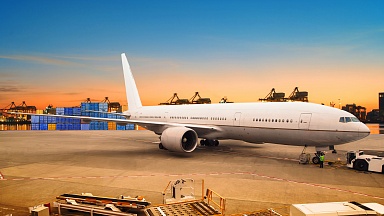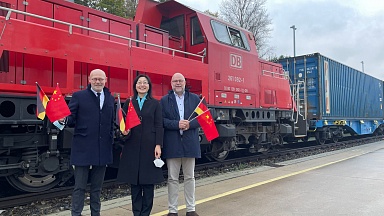Air cargo load factors and air freight rates continued their expected peak season climb in September, according to the latest global market data from industry analysts CLIVE Data Services.
CLIVE’s ‘dynamic loadfactor’ – which measures both the volume and weight perspectives of cargo flown and capacity available to produce a truer indicator of airline cargo capacity utilisation – rose to 68% in the last week of the month, higher than any pre-covid peak season level since CLIVE began sharing data in May 2018.
Data for September 2021 shows chargeable weight of +1% vs 2019, on a par with recent months, and +14% compared to September 2020, following +23% and +19% year-over-year growth levels reported in July and August 2021. As in previous months, CLIVE’s latest market intelligence reports compare performance to pre-covid 2019 levels as well as 2020 year-over-year comparisons, to provide meaningful analyses of the current conditions.
Capacity remained constrained at -13% versus the pre-covid level seen in September 2019. Compared to August 2021, global air cargo capacity was more-or-less flat on a like-for-like basis month-over-month.
Strong upward trend
The dynamic loadfactor for September overall remained at 66%, “but saw a strong upward trend towards the end of the month”, CLIVE noted. This growing demand was reflected in continued higher pricing levels, with the average rate in September 2021 following a similar trend to the previous month at more than double the average rates (+113%) in 2019. Versus 2020, following the + 15% pts rise in rates in August, September saw a +26% pts increase as demand vs. supply further improved the ‘sellers’ market’, highlighting the strain on the air cargo supply chain.
Niall van de Wouw, CLIVE’s managing director, commented: “This September data shows just the early stages of the typical Q4 (fourth quarter) surge, but many signals and commentaries seem to suggest that this will not be a ‘typical’ peak season. The recent week-over-week increase in load factor is a significant jump by any standards and shows the pressure on the air cargo supply chain is clearly further heating up. If airlines are micromanaging their capacity right now, they can benefit from it quite substantially.”
He added: “Currently, air cargo capacity is still largely controlled by cargo departments of airlines, and I see no reason why this will change in the immediate term. We might, however, not be too far away from this starting to change as certain lanes traditionally dominated by passenger flights begin to open up again for passenger travel, like the transatlantic.
“This is obviously extremely important to the long-term health and survival of passenger airlines, but it will also be a bittersweet moment after the heroics of the cargo industry. The role of air cargo within the airline boardroom will likely start to recede and impact the demand vs. supply ratio once again.”
CLIVE’s air cargo industry intelligence consolidates data shared by a “representative” group of international airlines operating globally. CLIVE’s ‘dynamic load factor’ analysis refreshes the way air cargo capacity usage is traditionally measured to reflect the “modern day reality” – that airlines’ cargo capacity nearly always ‘cube out’ before they ‘weigh out’ as a result of an aircraft’s higher capacity density (available kgs per cubic meter) than the average density of the goods moved by air.
Pricing upswing
As reported yesterday, the latest Baltic Air Freight Index (BAI) tracking of air freight pricing trends indicates that average Asia outbound air freight rates are “on a pronounced sequential upswing heading into peak season”, with that upswing “happening earlier this year – and off of a higher base”, highlighted Stifel’s Bruce Chan, director and senior analyst for Global Logistics & Future Mobility Equity Research. Hong Kong to Europe and North America prices were up 66% and 85% year-over-year, respectively, with both indices rising 21% and 13% since August.
Out of Shanghai Pudong (PVG), he noted that “the numbers are even starker. In September, the PVG to Europe basket (consolidated prices) rose 73% year-over-year and 38% since this August.” Chan added: “Absolute rates on Shanghai to North America are now within spitting distance of the absolute peak in 2Q20 when the PPE surge drove air cargo rates to historical highs.
“The reason for the earlier upswing, in our view, is that retailers were caught off guard for last year’s peak by strong demand and scarce capacity. This year, many are preparing earlier for the holidays, while trying to navigate severe and persistent supply chain disruption.
Short-term modal shift
TAC Index analyst Gareth Sinclair commented: “Disruption to supply chains has continued throughout September with more of the same causals we have seen in previous months and continued short term modal shift to air freight. Demand continues to be strong as economies continue to recover and open after restrictions with a strong peak expected and no likelihood of rates softening until the New Year.”
He highlighted that the BAI index finished the month at 4,272 which is the highest level since the index was first reported in January 2018, with the last highest level being 3,975 in mid-May 2020. This final full week of September level is +80% versus the equivalent week in 2020 and +279% versus 2019.
“With the index rising for nine consecutive weeks, it is 21% above levels seen at the end of August,” Sinclair noted. “All the 17 trade lane indexes were positive versus the end of August levels, ranging from a modest +0.3% on Frankfurt to USA, to +83% on Frankfurt to China.”
CN/HK Markets
Both the China and Hong Kong markets saw strong improvements in September over August of 24% and 15%, respectively, and both continued to show gains of around 50% versus last year. All the trade lanes from these markets were positive over August. Both indices to Europe saw similar month on month improvements, 31% and 27%, respectively.
But the difference between the ex-China and ex-Hong Kong markets was larger on flows to North America, with HKG +6% versus August levels whilst PVG was +24% – impacted by capacity constraints, Sinclair said. Hong Kong to Southeast Asia (SEA) finished the month +15% versus the last week of August.



